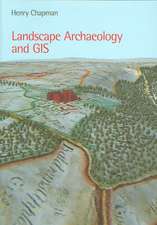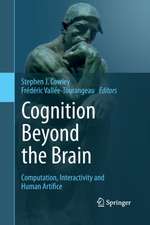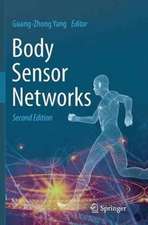Visual Heritage in the Digital Age: Springer Series on Cultural Computing
Editat de Eugene Ch'ng, Vincent Gaffney, Henry Chapmanen Limba Engleză Paperback – 27 sep 2016
The chapters contained within this volume present a broad range of technologies for capturing data (such as high-definition laser scanning survey and geophysical survey), modelling (including GIS, data fusion, agent-based modelling), and engaging with heritage through novel digital interfaces (mobile technologies and the use of multi-touch interfaces in public spaces). The case studies presented include sites, landscapes and buildings from across Europe, North and Central America, and collections relating to the ancient civilisations of the Middle East and North Africa. The chronological span is immense, extending from the end of the last ice age through to the twentieth century.
These case studies reveal new ways of approaching heritage using digital tools, whether from the perspective of interrogating historical textual data, or through the applications of complexity theory and the modelling of agents and behaviours. Beyond the data itself, Visual Heritage in the Digital Age also presents fresh ways of thinking about digital heritage. It explores more theoretical perspectives concerning the role of digital data and the challenges that are presented in terms of its management and preservation.
| Toate formatele și edițiile | Preț | Express |
|---|---|---|
| Paperback (1) | 650.27 lei 6-8 săpt. | |
| SPRINGER LONDON – 27 sep 2016 | 650.27 lei 6-8 săpt. | |
| Hardback (1) | 655.02 lei 6-8 săpt. | |
| SPRINGER LONDON – 17 dec 2013 | 655.02 lei 6-8 săpt. |
Din seria Springer Series on Cultural Computing
- 20%
 Preț: 648.26 lei
Preț: 648.26 lei - 20%
 Preț: 657.02 lei
Preț: 657.02 lei - 20%
 Preț: 167.45 lei
Preț: 167.45 lei - 20%
 Preț: 259.93 lei
Preț: 259.93 lei - 20%
 Preț: 332.89 lei
Preț: 332.89 lei - 20%
 Preț: 989.96 lei
Preț: 989.96 lei - 20%
 Preț: 660.48 lei
Preț: 660.48 lei - 20%
 Preț: 1308.39 lei
Preț: 1308.39 lei - 20%
 Preț: 936.37 lei
Preț: 936.37 lei - 20%
 Preț: 1164.84 lei
Preț: 1164.84 lei - 20%
 Preț: 334.20 lei
Preț: 334.20 lei - 20%
 Preț: 1165.69 lei
Preț: 1165.69 lei - 20%
 Preț: 937.43 lei
Preț: 937.43 lei - 20%
 Preț: 1046.24 lei
Preț: 1046.24 lei - 20%
 Preț: 1056.78 lei
Preț: 1056.78 lei - 20%
 Preț: 322.50 lei
Preț: 322.50 lei - 20%
 Preț: 940.47 lei
Preț: 940.47 lei - 20%
 Preț: 341.95 lei
Preț: 341.95 lei - 20%
 Preț: 1051.32 lei
Preț: 1051.32 lei - 20%
 Preț: 844.13 lei
Preț: 844.13 lei - 20%
 Preț: 1284.98 lei
Preț: 1284.98 lei - 20%
 Preț: 660.51 lei
Preț: 660.51 lei - 20%
 Preț: 897.79 lei
Preț: 897.79 lei - 20%
 Preț: 367.28 lei
Preț: 367.28 lei - 20%
 Preț: 1159.10 lei
Preț: 1159.10 lei - 20%
 Preț: 645.97 lei
Preț: 645.97 lei - 20%
 Preț: 338.16 lei
Preț: 338.16 lei - 20%
 Preț: 655.02 lei
Preț: 655.02 lei - 20%
 Preț: 648.95 lei
Preț: 648.95 lei - 20%
 Preț: 710.49 lei
Preț: 710.49 lei - 20%
 Preț: 1050.86 lei
Preț: 1050.86 lei - 20%
 Preț: 1164.05 lei
Preț: 1164.05 lei - 20%
 Preț: 1052.77 lei
Preț: 1052.77 lei - 20%
 Preț: 652.07 lei
Preț: 652.07 lei
Preț: 650.27 lei
Preț vechi: 812.83 lei
-20% Nou
Puncte Express: 975
Preț estimativ în valută:
124.43€ • 130.24$ • 103.56£
124.43€ • 130.24$ • 103.56£
Carte tipărită la comandă
Livrare economică 31 martie-14 aprilie
Preluare comenzi: 021 569.72.76
Specificații
ISBN-13: 9781447170822
ISBN-10: 1447170822
Pagini: 361
Ilustrații: XXIX, 361 p. 151 illus., 106 illus. in color.
Dimensiuni: 155 x 235 x 21 mm
Greutate: 0.55 kg
Ediția:Softcover reprint of the original 1st ed. 2013
Editura: SPRINGER LONDON
Colecția Springer
Seria Springer Series on Cultural Computing
Locul publicării:London, United Kingdom
ISBN-10: 1447170822
Pagini: 361
Ilustrații: XXIX, 361 p. 151 illus., 106 illus. in color.
Dimensiuni: 155 x 235 x 21 mm
Greutate: 0.55 kg
Ediția:Softcover reprint of the original 1st ed. 2013
Editura: SPRINGER LONDON
Colecția Springer
Seria Springer Series on Cultural Computing
Locul publicării:London, United Kingdom
Cuprins
Foreword by Ross Perry.- Seeing Things: Heritage Computing and the Arts and Humanities.- Digital Heritage: What Happens when we Digitize Everything?.- Digital Reconstruction of Archaeological Sites and Monuments: Some Experiences in South-Eastern Sicily.- Urban Scrawl: Reconstructing Urban Landscapes Using Documentary Sources.- Crossing Borders: A Multi-Layer GIS Mapping Framework for the Cultural Management of the Mundo Maya Region.- Situating Cultural Technologies Outdoors: Designing for Mobile Interpretation of Rock Art in Rural Britain.- Simulation and Visualisation of Agent Survival and Settlement Behaviours in the Hunter-Gatherer Colonisation of Mesolithic Landscapes.- Visualising Large Scale Behaviours: Presenting 4D Data in Archaeology.- Time and Tide: Modelling the Effects of Landscape Change on Population Support in the Southern North Sea.- Time and Tide: Modelling the Effects of Landscape Change on Population Support in the Southern North Sea.- Reconstructing a Painful Past: A Non-invasive Approach to Reconstructing Lager Norderney in Alderney, the Channel Islands.- A Theoretical Framework for Stigmergetic Reconstruction of Ancient Text.- Multi-Touch Tables for Exploring Heritage Content in Public Spaces.- More Than Just a Sum of the Points: Re-thinking the Value of Laser Scanning Data.- Resolving the Carving: The Application of Laser-scanning in Reconstructing a Viking Cross from Neston, Cheshire.- “There’s An App For That”: Building Smartphone Applications to Improve the Ergonomics of Landscape Study, Analysis and Interpretation.- Preserving our Digital Heritage: Information Systems for Data Management and Preservation.- Digital Heritage: Concluding Thoughts.
Textul de pe ultima copertă
Heritage is everywhere, and an understanding of our past is increasingly critical to the understanding of our contemporary cultural context and place in global society. Visual Heritage in the Digital Age presents the state-of-the-art in the application of digital technologies to heritage studies, with the chapters collectively demonstrating the ways in which current developments are liberating the study, conservation and management of the past. Digital approaches to heritage have developed significantly over recent decades in terms of both the quantity and range of applications. However, rather than merely improving and enriching the ways in which we understand and engage with the past, this technology is enabling us to do this in entirely new ways.
The chapters contained within this volume present a broad range of technologies for capturing data (such as high-definition laser scanning survey and geophysical survey), modelling (including GIS, data fusion, agent-based modelling), and engaging with heritage through novel digital interfaces (mobile technologies and the use of multi-touch interfaces in public spaces). The case studies presented include sites, landscapes and buildings from across Europe, North and Central America, and collections relating to the ancient civilisations of the Middle East and North Africa. The chronological span is immense, extending from the end of the last ice age through to the twentieth century.
These case studies reveal new ways of approaching heritage using digital tools, whether from the perspective of interrogating historical textual data, or through the applications of complexity theory and the modelling of agents and behaviours. Beyond the data itself, Visual Heritage in the Digital Age also presents fresh ways of thinking about digital heritage. It explores more theoretical perspectives concerning the role of digital data and the challenges that are presented in terms of its management and preservation.
The chapters contained within this volume present a broad range of technologies for capturing data (such as high-definition laser scanning survey and geophysical survey), modelling (including GIS, data fusion, agent-based modelling), and engaging with heritage through novel digital interfaces (mobile technologies and the use of multi-touch interfaces in public spaces). The case studies presented include sites, landscapes and buildings from across Europe, North and Central America, and collections relating to the ancient civilisations of the Middle East and North Africa. The chronological span is immense, extending from the end of the last ice age through to the twentieth century.
These case studies reveal new ways of approaching heritage using digital tools, whether from the perspective of interrogating historical textual data, or through the applications of complexity theory and the modelling of agents and behaviours. Beyond the data itself, Visual Heritage in the Digital Age also presents fresh ways of thinking about digital heritage. It explores more theoretical perspectives concerning the role of digital data and the challenges that are presented in terms of its management and preservation.
Caracteristici
Enlightens readers into the ways in which technologies are developing and how they are used within heritage, and where future developments will focus Presents cutting edge research on applied digital technologies to heritage, with sites, landscapes and buildings from across Europe, North and Central America, amongst others Broadens your understanding of new ways of approaching heritage, from the integration of historical textual data within landscape studies, to the use of agent-based modelling for the simulation of the past Provides case studies that extend across the field of heritage, including data capture, interpretation conservation, management and re-presentation across different platforms from mobile devices to multi-user multi-touch surfaces Includes supplementary material: sn.pub/extras























